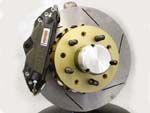
The phenomenon is fairly common in circle track racing. A racer will spend his last penny on his engine or a new set of tires, while ignoring his brake system. Good braking just isn't as sexy as fire-breathing power, or a handling package that makes the car feel like it is riding on rails. In truth, the braking system--and its ability to stop the car quickly, consistently, and without upsetting the suspension--is vital to getting around the track quickly. This ain't drag racing after all. Unless you are racing Daytona or Talladega, you are probably using the brakes at least twice every lap to keep from wadding your car into the wall.
Racers need to consider the braking systems used by professional teams. In many cases, the higher initial cost pays for itself in short order.
Mark Davis, owner of the Carolina Motorsports Tech Center in Conover, North Carolina, recently upgraded the brakes on his Hooters ProCup car. The racing team, known as Carolina Team Concept, is made up of students from the CMTC, but the car is funded just like every other race operation. The goal at the track, just like every other team, is to win.
"We don't have the budget some of the other cars do," Davis says. "But we try to make sure we always do what it takes to win. I know a lot of guys will pinch pennies and think that as long as the brakes don't outright fail, they've done their job. That doesn't address the performance aspect of how the right brake package can help you get around the track: how light they are, how well they resist fading, how stable the calipers are. Things that help you go as fast in the last 10 laps as you did in the first 10. In my opinion, if a part can help you make the move from a Top-5 finish to a win, then it's worth some extra money."
Don Everhart of North American Race Parts provided technical support for this project. Everhart regularly advises race teams at every level on pad/rotor/caliper combinations that best suit their needs. It may sound odd, but hardware choices are actually harder for the Saturday night racer than for the Winston Cup guys. For the regular guy, outright performance and total weight aren't the only determining factors, there's also money and longevity to consider. For our needs, racing the Northern Division of the ProCup Series (Busch-type cars on short tracks), Everhart pointed us toward Alcon six-groove rotors, which are light, at just 11.9 pounds each, but should last the greater part of a season under hard use. For calipers, we chose Alcon B-Type units for the front, which are high-end pieces, but weigh in at just 6.3 pounds each. Even lighter H-Type units (4.5 pounds) were selected for the rear wheels. Performance Friction pads will do the dirty work.
"This isn't an overpowering brake system," Davis says. "But that's OK because we don't want to be hauling a bunch of weight around the track on the wheels. If the brake system is installed correctly and cooled properly, you don't need as much. That's the trick."
Both Davis and Everhart agree that the best thing you can do to ensure dependable stoppers during a long race is to put in the time beforehand. That means regular rebuilds (every four or five races), which include replacing all the seals, as well as changing the brake fluid every week. You need to keep a close watch on fluid temperatures. If you are spiking into the boiling point every week, you need to rethink your cooling system. Recirculators probably aren't necessary, but make sure your ductwork is as straight as possible and unclogged. Just like airflow to the combustion chambers, you want to provide air to cool the brakes in as straight a shot as possible.